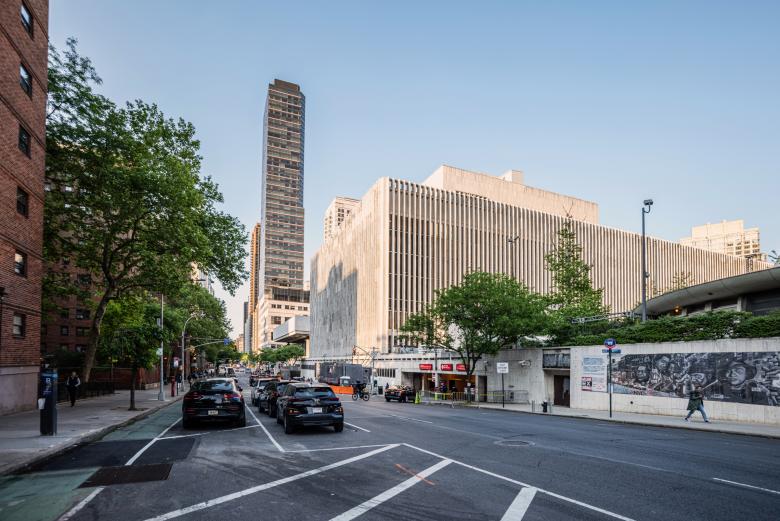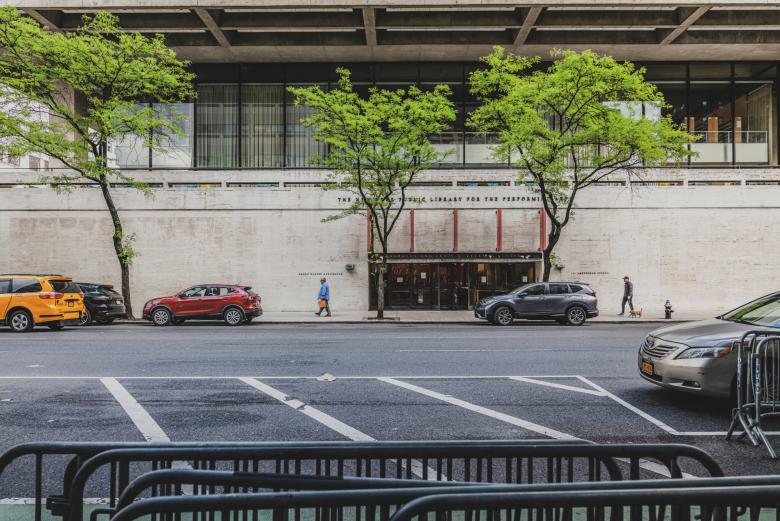4. March 2024
Looking north up Amsterdam Avenue from 62nd Street. (Photo: Lawrence Sumulong, courtesy of Lincoln Center)
The Lincoln Center for the Performing Arts has announced that the team of Hood Design Studio, Weiss/Manfredi, and Moody Nolan has been selected to reimagine the Amsterdam Avenue side of its famed Upper West Side campus. The selection is part of an ongoing participatory planning process that started last summer.
Most people who visit Lincoln Center arrive from the east, from Columbus Avenue and the subway tucked below Broadway. The trio of the institution's main buildings and the plaza they face clearly orient themselves to the east, thereby turning their backs on Amsterdam Avenue, which also happens to be where the housing component of the larger Lincoln Center development was built in the early 1960s. (The housing was needed to obtain federal Title I funds.) What was acceptable in the decades following World War II is anathema today: Lincoln Center cannot continue to wall itself off from the public housing and other communities to the west. New Yorkers familiar with Lincoln Center will know that the campus does just that: a continuous, travertine street wall extends a full three blocks from 62nd Street, near Damrosch Park, to 65th Street, punctured only by loading and parking access and an entrance to the Performing Arts branch of the New York Public Library.
The entrance to the New York Public Library for the Performing Arts on Amsterdam near 65th Street. (Photo: Lawrence Sumulong, courtesy of Lincoln Center)
Ever since Diller Scofidio + Renfro won a 2002 competition for the transformation of Lincoln Center, there has been a shift toward inviting a wider public into the arts campus and addressing the place's troubled origin story, in which some 20,000 residents of San Juan Hill were displaced in the 1950s to make way for what became known, sometime after it opened in 1962, as an “Acropolis for the cultural elite.” Numerous changes by DS+R — ranging from barely perceptible touches to building extensions, from demolition to new construction — have helped make Lincoln Center more hip, less stuffy. The process has continued with other architects, as in David Geffen Hall, which reopened in fall 2022 with a lobby, bathrooms, and other publicly accessible spaces reworked by Tod Williams Billie Tsien Architects. But the institution had yet to address its “back door” on Amsterdam Avenue. Until now.
The Hypar Pavilion at Lincoln Center, is part of the earlier transformation led by Diller Scofidio + Renfro. (Photo: John Hill/World-Architects)
The design team that “will create proposals based on ideas and feedback from more than 3,400 New Yorkers who have participated in a robust and ongoing participatory planning process focused on making the campus more welcoming and accessible for all New Yorkers,” per today's announcement, is made up of:
- Hood Design Studio, landscape designer
- Weiss/Manfredi, design architect
- Moody Nolan, architect of record
Today's announcement is a welcome one, though it is not a complete surprise, given that the institution announced its intentions to improve Amsterdam Avenue last June. The team is a commendable one. Hood Design Studio is led by Walter Hood, who “believes public spaces should confront difficult truths.” The multidisciplinary firm of Marion Weiss and Michael Manfredi is adept at designing structures integrated with landscapes, quite a few of them in the tricky confines of New York City. And Moody Nolan is notably the largest African American-owned architecture firm in the country.
Damrosch Park, looking west (Photo: NADAAA, courtesy of Lincoln Center)
What will the design team be doing? What was learned from the participatory planning process? The first phase of the project will focus on Damrosch Park, the large outdoor venue at the southwest corner of the campus, to make it more publicly accessible while transforming it into a state-of-the-art performance park. This location will allow the design team to explore design opportunities focused on making the institution's interface with Amsterdam Avenue more accessible, inclusive, and welcoming.
The findings of the participatory planning process, which involved surveys, interviews, focus groups, workshops, and other components carried out with NADAAA, the firm of Nader Tehrani, yielded a laundry list of considerations for the design team, many of them focused on Damrosch Park:
- A community-centric approach that emphasizes interaction and communication through thoughtful design
- A welcoming entrance that offers pathways where everyone can enter, regardless of physical ability
- A dedicated area for community performances and flexible exhibit spaces for new talent and community-generated artwork
- Greenery and sustainability
- Food options during events should reflect different cultures and ethnicities
The design team will now take the input and start work on designs for a reimagined Damrosch Park, continuing to work with the community. At this early stage, though, there is no indication when we will see images of their designs, or when Lincoln Center is hoping to start construction on the first phase.



